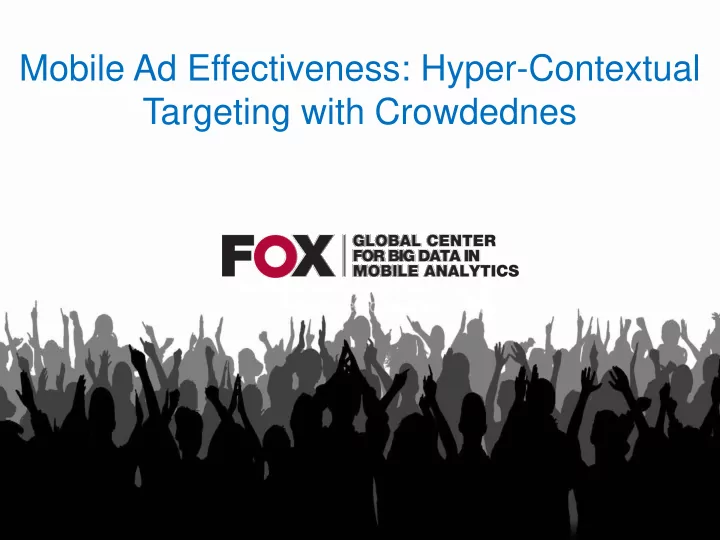

Mobile Ad Effectiveness: Hyper-Contextual Targeting with Crowdednes
2
Mobile Targeting Motivation • Ad spending: $100B by 2018 • Key: reach consumers when and where most receptive 3 eMarketer 2014
Mobile Technology • Portability = Real-time Targeting • GPS, Wi-Fi, Bluetooth, iBeacon = Geo-Targeting 4
Mobile Targeting with Crowdedness • Mobile technology can gauge crowdedness on-the-go 5
Research Objective (1) How does crowdedness affect consumer response to mobile targeting? (2) What drives the results? 6
Research Design • Ideal test of crowding effects: • randomize crowdedness • Our test: • field data measuring crowdedness with mobile technology 12
Overview of Results • Crowding positively affects mobile ad purchase • Crowding invades space so people turn inwards • Results opposite of crowding literature • Crowding in retail stores decreases purchases • May be a different manifestation of avoidance 10 Harrel et al. 1980; Zhang et al. 2014
Overview of Results • Paradox of crowded environment • Noise distracts consumer attention to ads • But, crowding boosts attention to signal of mobile ads 11 Bart et al. 2014; Ghose and Han 2014
Prior Research 11
Mobile Research • Mobile internet search behavior • Coupon redemption rates • Time and location (*my forthcoming Management Science paper) • Geographic mobility 12 Ghose et al. 2013; Molitor et al. 2014; Luo et al. 2014; Ghose and Han 2011
Mobile Research • In-store mobile promotions • Product characteristics • Cross-platform synergies • Environmental factors 13 Hui et al. 2013; Bart et al. 2014; Ghose et al. 2014; Molitor et al. 2013
Crowdedness Research • Disease and juvenile delinquency • Stress, frustration, hostility • Felt loss of control 14 Schmitt 1966; Collette and Webb 1976; Zimbardo 1969
Crowdedness Research • Avoidance behaviors • Threatened sense of uniqueness • Risk aversion 15 Harrell et al. 1980; Xu et al. 2012; Meang et al. 2013
Field Data (Quasi-field experiments) Business Weekend Weekday Day Exogenous Crowding 16
Measuring Crowdedness • passengers/m²: Subway mobile users connect to subway- specific cellular line 17
Parts 1 & 2 Targeted subway population: 2 million commuters • • Sample size: pushed to 10,360 mobiles • Weekday and weekend 18
Mobile Message • 20 Minute Expiration • Promotional Discount 19
Self-Selection Threats (1) Peak hours vs. non-peak hours of crowdedness • 5 times (7:30-8:30, 10-12, 14-16, 17:30-18:30, 21-22 hrs) • Subway station and direction (2) Weekdays and weekends 20
Self-Selection Threats (cont’d) (3) Randomization • Excluded users who had the service or received the SMS already • Randomized remaining users and pushed SMS. (4) Personal mobile usage habits – ARPU – MOU – SMS – GPRS 21
Additional Self-Selection Approaches • Same-train-same-time subsample analysis 22
Additional Self-Selection Approaches • Propensity score matching Control 17.5 N 391 Mean 0.39 15.0 Median 0.38 12.5 Mode . Percent Normal 10.0 0 Kernel Normal 7.5 5.0 2.5 Traffic 0 17.5 N 391 Mean 0.39 15.0 Median 0.38 12.5 Mode . Percent Normal 10.0 1 Kernel Normal 7.5 5.0 2.5 0 -0.06 0 0.06 0.12 0.18 0.24 0.30 0.36 0.42 0.48 0.54 0.60 0.66 0.72 0.78 0.84 0.90 0.96 ps Treatment 23
Effect of Crowdedness 4.1 49.5% Purchase Rate (%) 3.9 3.7 3.5 3.3 16% 3.1 2.9 2.7 2.5 0.91 1.96 3.05 4.02 4.97 Crowdedness as Passengers/m² 24
Endogeneity Threat • Identification with street closures 20
Street Closure Crowdedness 4.5% 4.0% 3.5% Purchase Rate 3.0% 2.5% 2.0% 1.5% 1.0% 2.11 2.72 3.05 3.54 3.99 4.13 22 Crowdedness as Passengers/m²
Main Evidence for Crowdedness Effect Parameter Model 1 Model 2 Model 3 Model 4 Crowdedness .492** X (.187) Street Closures .126** .114** Crowdedness (.041) (.042) -.120 -.142 -1.887 Street Closures (.117) (.177) (1.057) Ln(ARPU) .301** .308** .308** .306** (.118) (.119) (.119) (.119) Ln(MOU) -.043 -.043 -.044 -.044 (.065) (.065) (.065) (.065) Ln(SMS) .014 .014 .015 .013 (.069) (.069) (.069) (.069) Ln(GPRS) -.001 -.001 -.001 -.001 (.024) (.023) (.023) (.023) Day(weekday) Effects Yes Yes Yes Yes Train (time cycle) Effects Yes Yes Yes Yes Observations 11,960 11,960 11,960 11,960
Endogeneity Threat Identification with unanticipated train delays 24
Train Delay Crowdedness 7.5% 7.0% Purchase Rate 6.5% 6.0% 5.5% 5.0% 4.5% 4.0% 3.04 3.14 3.63 4.71 25 Crowdedness as Passengers/m²
Lower Threshold Subsample with Low Crowdedness (under 2 passengers/m 2 ) Parameter Model 1 -.084 Crowdedness (.270) Mobile Behaviors Yes Day(weekday) Effects Yes Train (time cycle) Effects Yes Observations 2,886 30
Upper Threshold 32
More Evidence with Field Surveys Participants: 300 Purchasers & non-purchasers Survey Response: 240 of 300 mobile users = 80%. Mobile Immersion 1.375 *** .152 * .465 *** Crowdedness Immersion Involvement Purchase 33
THANK YOU! Xueming.Luo@temple.edu 33
Recommend
More recommend